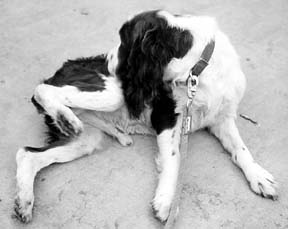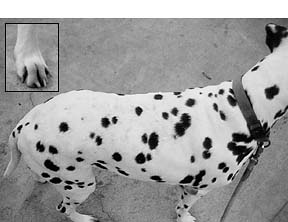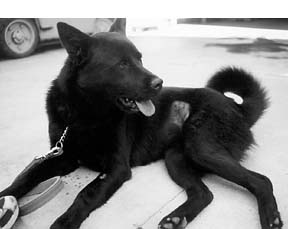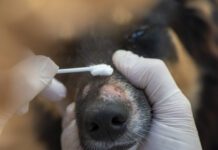Quick: What’s the number one canine disease complaint heard by veterinarians? That’s right, it’s itching and scratching. “My dog is ripping himself to shreds!” “She’s almost bald from chewing herself!” “He’s rubbing himself on the carpet, the furniture, and even the walls!”
Many people seem to think that all dogs scratch themselves. Of course, pretty much every dog will scratch for a moment if they get a little itch, but that’s not what we’re discussing. The scratching we’re discussing – the scratching that is of real concern – is not occasional or casual. We’re going to talk about real scratching: the urgent kind that makes your dog stop walking in mid-stride to scratch, the frantic kind that makes him whine and moan while he strives to put out the flames under his skin, the single-minded kind that causes him to traumatize his skin (often initiating secondary bacterial infections), ruin his coat, and wear down his incisors.
Hair loss is most often, but not always, associated with self-trauma caused by itching. This happens in one of two ways: Either the hair follicles themselves become physically damaged when the dog scratches or chews himself, or the trauma-induced inflammation in the skin around the hair follicles causes the hair to fall out. Hair loss not associated with itching or scratching can be caused by drug reactions, endocrine, metabolic, systemic diseases, or nutritional factors, but these conditions are in the minority. It is far more common for hair loss in dogs to be associated with self-trauma due to pruritis (itchiness).

Severe pruritis can also change a dog’s behavior, causing a lack of usual tolerance, aggressive behavior, or increased anxiousness. The dog may become frantic and easily distractible, compulsively engaging in a frenzied fit of scratching and chewing.
Some environmental conditions can amplify the itching, including heat, cold, and low humidity. Boredom or anxiety (especially separation anxiety) can trigger a fit of itching, too.
Allergies are the most common cause of itching, scratching, chewing, and any other sort of self-inflicted skin trauma, but these problems can also be triggered by internal diseases such as hypothyroidism, hyperadrenocorticism, liver, pancreatic, or renal disease; bacterial, fungal, or parasitic infections; immune-mediated disorders such as systemic lupus erythematosus (SLE), a drug reaction, or a contact dermatitis from exposure to a caustic agent. For this reason, if your normally non-itchy dog suddenly begins losing hair in patches and scratching himself, your first course of action ought to be making an appointment with your favorite veterinarian.
The veterinary examination
To determine the cause of your dog’s itching, a veterinarian will need to take a thorough history and conduct a thorough physical examination. She may also want to take some tests, and will probably suggest trying at least a short-term course of corticosteroids and/or antibiotics, avenues of treatment which is also somewhat diagnostic (food allergies are less responsive to corticosteroids than atopic dermatitis or flea allergy dermatitis, and pyoderma diminishes with antibiotics).

To compile your dog’s health history, the veterinarian will ask about the dog’s diet, environment, and past history of skin conditions. Where does the dog sleep? How often does he get a bath (too-frequent shampoos can dry the skin and make it pruritic)? What sort of heating system warms your home (non-humidified forced air and wood stoves can dry the skin)? She’ll also want to know about the presence of any other pets in the household (some dogs are allergic to birds or bird feathers, for instance), and she’ll probably ask whether any person in the household has allergies or itching of any kind (scabies infections can be transferred from people to pets and vice versa).
Then she’ll need information about the onset of the condition your dog currently exhibits. Have there been any changes in the dog’s life? Diet changes? A new bed? A new cat in the house? A new shampoo? A different floor or carpet cleaner used? She’ll want to know when the dog seems more or less affected by itching (when it’s hot? cold? indoors? outdoors? morning? night? spring? fall?). All the answers to these questions may be indicative of certain diagnoses.
In building a diagnosis, your veterinarian will also take your dog’s age into account, since some skin diseases, such as mange, are more common to younger dogs, and some are more commonly seen in older dogs, such as food allergies and pyoderma. She will also consider the dog’s breed, since some skin diseases are more common to some breeds than others, for genetic reasons.
And, obviously, the veterinarian will also examine your dog’s skin, from nose to tail, including a careful look at the dog’s ears, genitals, and paws (which are often inflamed with certain allergies). She’ll look in the dog’s mouth (worn teeth are often indicative of a dog who chews himself chronically), and check the dog’s lymph nodes for swelling. She’ll look at the dog’s pattern of hair loss and quality of the skin, including any skin lesions.
Laboratory tests for a pruritic dog may include skin scrapings (which are examined under a microscope), smears or tape preparations (in which any skin exudates are smeared and stained on a slide and examined microscopically); or skin biopsy (contraindicated in lesions are present). Dermatology specialists are generally best qualified to conduct intradermal skin testing, in which the dog is deliberately exposed to minute amounts of various antigens and any resulting reactions are noted.
General recommendations
for an itchy dog
We can’t possibly comment on every treatment for every cause of canine itching and scratching, but we will offer our opinion of some traditional medical treatments, as well as some general recommendations for holistic complementary and alternative treatments for an over-itchy dog.
Keep this important concept in mind as you deal with a pruritic dog: An intense itching sensation is a serious symptom of ill health; it’s not a disease in itself. Your goal with any course of treatment – traditional or alternative – should be to determine and solve the underlying health problem that caused the itching, not to simply “stop the itch.” Eliminating the only obvious expression of ill health that the dog’s body is making will not make his health any better. It might make his coat grow in and let you sleep at night, uninterrupted by his fits of scratching, but the basic imbalance that caused the pruritis will still be present, and it may well find an even more noxious outlet in the dog’s body.
Ridding your dog of fleas
Fleas are one of the leading causes of canine pruritis. They can make a dog itch through two mechanisms: through an allergic reaction to flea saliva, and from chemical and mechanical irritation. Flea saliva contains an anticoagulant substance that keeps the blood in the tiny bite wound from clotting, thus permitting the flea to take a nice, long drink, at the dog’s expense. The flea saliva also contains other substances that can irritate the dog’s skin. Flea bite dermatitis is the name for the condition characterized by inflammatory papules (a small, raised, pimple-like skin bump) at the site of the flea bites. The amount of irritation with this condition is directly correlated to the size of the dog’s flea population.
On the other hand, a dog that is allergic to flea saliva – one who is said to suffer from flea allergy dermatitis – may have a response that is completely out of proportion to the severity of the flea infestation; the dog may react as badly to the bite of a single flea as it would to an army of the tiny insects.
The dog owner’s first priority, no matter which type of reaction his dog may be exhibiting, is to eliminate fleas in the dog’s environment. Frequent vacuuming (to get rid of flea eggs), routine washing of the dog’s bedding (water destroys flea eggs, too), and the use of a non-toxic flea killer such as diatomaceous earth in your carpets will help you keep the upper hand in the battle. (See “Flee, Evil Flea,” WDJ June 1998 for a complete discussion of non-toxic methods of ridding fleas from your home.)
Should I “Spot” the dog?
As for the “miraculous” new chemicals used for flea control (the ones that are applied to the dog’s back, once a month), we’ll just comment that among holistic practitioners, the advent of the new substances is not generally considered an altogether positive development. While these treatments have demonstrated an admirable effectiveness in wiping out resident flea populations, many holistic veterinarians are concerned with the long-term effects that these powerful chemicals may have on dogs, and some dog owners and vets have seen dogs who have suffered serious reactions following their application.
Like all toxic treatments, these chemicals ought to be used sparingly; some people use one-quarter the recommended amount, and only when fleas are seen in the environment (as opposed to once a month application, whether needed or not, as suggested on the labels!) with good results.
Corticosteroids
There are almost as many opinions among veterinarians concerning the use of corticosteroids as there are veterinarians. Some feel that these drugs – prednisone, prednisolone, methylprednisolone, and dexamethasone foremost among them – are invaluable to every dog who itches; some feel that corticosteroids ought to be used only as a last resort, and only for short periods and in small amounts. Still others, most holistic practitioners among them, regard them as verboten.
Corticosteroids, also known as glucocorticoids, are used mainly for their anti-inflammatory and immunosuppressive effects. They have been modeled on the substances manufactured by the adrenal cortex, and can be administered in an indictable, oral, or topical form. These are powerful drugs that exert amazing effects on pruritic dogs – sometimes overwhelmingly positive, and sometimes negative. They can halt inflammation and itchiness within just a day or two, and, thorough a complex process, interrupt the out-of-whack cycle of allergic overreactions to environmental triggers (pollen, dust, fleas, mold, fungi, etc.).
However, due to their immunosuppressive action (which is responsible for quieting the allergic cycle), they can also leave a dog vulnerable to infections, and can cause a host of other metabolic imbalances. They affect water and electrolyte balance (making many dogs excessively thirsty, and thus, excessively in need of “going outside”); they can cause extracellular fluid retention (some dogs will take on a puffy appearance); and they often increase the dog’s appetite (and without owner awareness of the potential for problems, resultant gain of unhealthy pounds). The long-term use of these drugs also prompts the adrenal glands to stop producing its own corticosteroids, effectively ruining the dog’s ability to produce a natural and appropriate supply of these substances by himself.
Some veterinarians, frustrated with a lack of willingness on the part of some owners to engage in a multi-pronged, active course of therapy for their itchy dog, will prescribe the drugs in order to – at least temporarily – stop the dog’s itching and increase his quality of life, at least in the short term.
In general, it makes sense to regard these drugs as “heavy artillery,” even if your own veterinarian is casual about prescribing them on an initial visit. Holistic veterinarians generally advise using them as a last resort and just for a short time (two weeks or so), to help halt the itch/scratch cycle plaguing a severely pruritic dog. This, in turn, can give his skin time to heal, and other therapies time to begin working.
Antibiotics
Antibiotics are sometimes recommended in cases of severe trauma to the skin, and when there are indications that a secondary infection is overwhelming the dog’s ability to heal itself. Again, these drugs are generally considered by holistic veterinarians to be a last-ditch approach, and only when the dog appears incapable of mounting an appropriate response when supported by more natural therapies. Holistic practitioners often recommend that a course of antibiotics is always supplemented and followed with a course of oral probiotics, to help beneficial bacteria killed by the antibiotics re-colonize in the dog’s digestive tract.
Antihistamines
Histamine blockers can be beneficial in the treatment of allergic pruritis, by inhibiting the excessive histamine that causes most of the signs commonly attributed to allergy: itching, watery eyes, and runny nose. However, in order to be most effectively prescribed, the veterinarian should have conducted enough tests and observed the dog’s signs over enough time to have a high degree of confidence that the pruritis is allergic in origin.
The usefulness of antihistamines – even in dogs known to be allergic to a certain substance – is reduced by the fact that studies have shown that only about 30 percent of any given group of allergic dogs will respond to any given antihistamine. In other words, a veterinarian might have to try several drugs before one is found to be effective for a given dog.
Just because many people use antihistamines on a very casual basis should not lead one to believe that their use in dogs can be similarly indiscriminate. Antihistamines are contraindicated for dogs with glaucoma, cardiac arrhythmia, disorders of the central nervous, gastric, urinary, or hepatic (liver) systems, and pregnant dogs.
Diet considerations
Dog foods can contribute to skin problems in two major ways: through food allergies, and through poor nutrition. We’ll deal with food allergies first. When veterinarians begin to pinpoint food allergies as contributing to a dog’s pruritis, their usual recommendation is to feed the dog what is called an “elimination diet,” a food consisting of just one protein source and one carbohydrate source that are not present in the dog’s regular food.
Elimination diets, whether commercial or homemade can be a fantastic tool for determining which foods your itchy dog should avoid. If the dog’s itching seems to decrease on this diet, then other ingredients may be added to the dog’s food one at a time until the dog reacts with increased itching. Whichever ingredients were most recently added are then suspected of causing the allergy.
Several commercial food makers have developed foods consisting of simple combinations of offbeat ingredients (duck and potato, for instance, or venison and amaranth) in order to assist the dog owner in identifying a specific food allergy, so the owner can avoid the implicated food ingredients in the dog’s food forever after. It should be noted that these foods are not “hypoallergenic” as some people think; they simply contain foods that the dog is not likely to have encountered before in the usual dog foods. Some dogs may be allergic to these offbeat ingredients, too.
People should also be aware that it is possible for a dog to be allergic to some small, overlooked component of commercially prepared foods: a certain preservative, for instance, or a specific source of certain vitamins or minerals. For this reason, there is a distinct advantage to homemade elimination diets, in which you can control every ingredient.
Few people like to hear that many problems of the dog’s skin are related to poor nutrition and/or poor quality foods. The most common retort to this accusation? “I spend a lot of money on dog food – I get the most expensive one at the grocery store!”
As we discussed in “Top Dry Dog Foods,” (on page 3 of this issue), only a tiny percentage of the commercially prepared dog foods sold today are as healthful as these foods could and should be. Most foods are laden with artificial preservatives, colors, flavors, and other chemicals that can trigger allergic reactions in dogs, or create extra work for the dog’s hepatic (liver) system to filter these chemicals out of the dog’s system. Over years of eating foods that are laden with these unneeded substances, the body’s toxin-removal systems get overworked and “backed up;” toxins begin to accumulate in the body. Since the skin is, among other things, an organ of elimination, the toxic backup may result in poor skin health.
Holistic practitioners recommend switching any itchy dog to a home-prepared, “real foods” diet in order to decrease the dog’s exposure to unnecessary chemicals and to give his body the opportunity to utilize the higher-quality nutrients present in fresh foods. While some advocate diets consisting mostly of raw meat with some vegetables and grains (see “The Meat of the Matter,” WDJ January 1999 and “Getting a Raw Deal,” WDJ September 1999) others prefer home cooked foods. Whether the food is cooked or not, the increased nutrient quality and availability of real, fresh meats, vegetables, and grains will improve the health of any dog who is currently receiving even the “best” dry or canned foods.
Herbs
Renowned herbalists Mary Wulff-Tilford and Greg Tilford, co-authors of the incredible 1999 book, All You Ever Wanted To Know About Herbs For Pets, characterize herbs as being one of the most useful complementary therapies for pruritis and all other canine maladies, due to their unique, gentle, synergistic action within the body. In the book’s section on skin problems, the authors write: “The function of the herbalist is not to substitute the body’s natural methods of treating disease with new methods, but to assist the body in healing itself naturally.”
To this end, the Tilfords suggest first improving the pruritic dog’s diet, and then attempting to rule out certain allergens, before adding herbs to your therapeutic regimen. This will set the stage for success with herbs such as horsetail and gotu kola to help regenerate and strengthen the skin structure; nutritive herbs such as spirulina, nettle, alfalfa, and red clover to provide trace minerals and antioxidant vitamins, and fresh burdock root as a blood cleanser.
An entire issue of WDJ could be devoted to herbal remedies for various skin problems. Those who are inclined to use herbs should seriously consider the purchase of the Tilford’s book, which offers detailed instructions on sources, dosages, and preparation of herbal remedies for animals. (See “Resources for Healthy Skin,” below, for ordering information.)
Acupuncture
Scientific studies are revealing what holistic practitioners have seen for themselves for ages: This ancient Chinese art has unlimited gifts for dogs. Chief among them is the ability to somehow trigger the dog’s own healing process from a variety of illnesses.
Following acupuncture for allergies or other causes of pruritis, practitioners of this traditional Chinese medicine would attribute improvements in the dog’s health to the ability of acupuncture to restore the healthy flow of internal energy, known as qi or chi.
Western practitioners of this 3500-year-old practice might prefer to credit the improvements to the ability of acupuncture to increase circulation, and to reduce pain and inflammation by increasing the production and release of the body’s own pain-killing, mood-elevating chemicals.
Either way, it is certain that acupuncture is an important part of many formerly itchy dog’s ongoing therapy (see “Hard Work, Huge Rewards,” the case history of a chronically pruritic dog).
To locate a qualified veterinary acupuncturist near you, see “Resources for Healthy Skin,” below.
Reducing exposure to toxins
Anything you can do to lessen the detoxifying burden placed on the dog’s liver will help the dog in the long run. Keep your vaccination program to the safest minimum. Try to eliminate any unnecessary chemicals that your dog might be exposed to in your house and garden, including toxic flea killers, chemical insecticides of any other kind (fly, ant, or cockroach killers, fertilizers or weed killers, floor polishes or carpet cleaners, disinfectants, deodorizers and “carpet fresheners,” fabric softeners, medicated shampoos, etc. In many cases, non-toxic yet effective alternatives exist for these substances.
Recording changes
Perhaps the most valuable thing a dog owner can do is to keep track of all the changes in his dog’s life in an attempt to correlate the problems with a cause. Keeping a “canine health diary” is the best way to do this. Record any changes in his appearance and behavior, and note any changes in the household that might affect him: Are you using a new floor wax in the kitchen? Did you baby-sit a friend’s dog for a few days, one that might have brought in a new flea population? Did you leave your dog in the care of a petsitter while you were out of town on a business trip, triggering a major episode of separation anxiety?
In particular, you should note any changes in the dog’s diet. Indicate when you may have added or subtracted something from his diet, or even when you brought home a new sack of the same kind of dog food. (After two weeks of my dog’s unexplainable itching, I finally looked at the label of the sack of the “same old food” I had bought two weeks before . . and discovered that the maker had added ONE new ingredient, and one that old Rupert apparently could not handle.)
Hopefully, this sort of health journal will yield a clue as to the identity of any substance that aggravates your dog’s allergy or hypersensitivity. It may also help you determine which treatments are not improving his condition. At the very least, it will make it a lot easier to report your dog’s history to any veterinary practitioner you consult.
Don’t give up!
Perhaps the worst experience of preparing this article was my visit to my local animal shelter to look for dogs with skin problems that I could photograph.
Out of the 30 or so dogs in the shelter on the day I went, I was able to find at least 10 or so that exhibited some scratching or chewing, and three that had fairly major skin problems: A stately older Dalmatian with red, inflamed feet and bumpy blemishes all over his back, a young, sweet but frantically active Chow with several large bare and bleeding patches of skin that she attacked with her teeth every few minutes, and a very old Springer Spaniel who was, as the shelter staff described him sympathetically, “a total mess.” When compared to their blemish-free shelter companions, their chances of making it out of the shelter and into a home were pretty slim.
The old Spaniel had been, in fact, released to the shelter by his owner, who had been either what I would regard as criminally negligent in attempting to help his dog, or, perhaps, completely unable to find (or afford) treatments that helped the dog. With pus-filled eyes and goopy, painful infected ears, hideously inflamed and thickened skin, and an odor that could knock you over, this poor old dog was scheduled to be humanely euthanized as soon as the state-mandated “hold period” had passed.
I spent almost an hour with the dog, holding my breath as I petted and fussed over him, but he was so distracted by his own frantic attempts to relieve his itching that he seemed to hardly notice me. After I had photographed him, I had to go home and throw all my clothes in the washing machine and take a shower, the smell was so bad. I wept with sadness for the poor dog, who had to live in that skin. He was a living illustration of the fact that allergies and skin problems caused by other conditions only get worse as dogs get older, as their immune systems grow weaker and less able to respond appropriately.
Treating skin problems can be a long, slow, costly experience, but, as I saw at the shelter, “stopping the itch” is not just a matter of making the dog more comfortable, and making you more comfortable being around him, it may actually be a matter of life or death. But no matter how frustrating the process is, don’t give up: a calm dog with a shiny coat may be just one more treatment away.
Also With This Article
Click here to view “Correcting Canine Skin Problems”
Click here to view “Home Remedies For Your Dog’s Skin Inflammation”
-By Nancy Kerns






